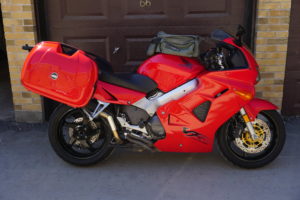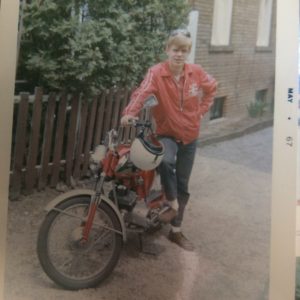 May 21: I sold my beloved Honda VFR motorcycle this morning. I’ve been riding bikes for 45 years and owned her for 18 of them. She was the last in a long line of machines that extends back to the 1967 Yamaha 100 Twin that was my first bike. In the interim there have been larger Yamahas, Hondas, a BMW and a Moto Guzzi. I’ve enjoyed them all – some more than others – but the time has come to step back from riding.
May 21: I sold my beloved Honda VFR motorcycle this morning. I’ve been riding bikes for 45 years and owned her for 18 of them. She was the last in a long line of machines that extends back to the 1967 Yamaha 100 Twin that was my first bike. In the interim there have been larger Yamahas, Hondas, a BMW and a Moto Guzzi. I’ve enjoyed them all – some more than others – but the time has come to step back from riding.
I was extremely fortunate to spend the last three pre-COVID summers riding in Europe. Those days are unforgettable, but with the on-going pandemic, it is not something I will be doing again any time soon. In the absence of those protracted adventures, I’ve been riding less and less here at home. I know that my riding skills have significantly diminished.
There is an axiom which says that a motorcycle is a rolling physics experiment. The wheels are essentially two large gyroscopes linked by a motor and chassis. Like any gyroscope, when in motion a motorcycle wants to do nothing more than remain upright and go in a straight line. Even a simple action like turning a bike requires a special skill set or the physics experiment will end badly. Turn into a right hand highway on-ramp by pushing the handlebar to the left. If you turn too sharply, open the throttle. This increases speed and expands the radius of the turn. If you find you are not turning sharply enough, roll off the gas and the bike will fall into the corner and the radius of the turn will diminish.
These skills, and many others, have to be ingrained. In an emergency, a rider can’t be trying to recall whether to push or pull the handlebar to swerve. This brings us to another axiom: There are two types of motorcyclists: those who have crashed, and those that are about to crash.
At some point, whether through our own foolishness or lack of skill, the laws of physics assert themselves. The crash you encounter may not be of your own making. Roughly 65% of motorcycle crashes are caused by another vehicle failing to yield right of way to the motorcycle – typically by turning left directly in front of a bike passing through an intersection – and about 30% of crashes are the fault of the rider. These include causes like failing to negotiate a turn (through too much speed or too little skill).

In the last four decades of riding, I’ve had several low speed tip-overs that did little damage to anything other than my ego. My one bad crash involved hitting a patch of gasoline or anti-freeze on Highway 11 and leaving the road at about 100 KM/H. I felt the front wheel tuck under the bike, and after that, not much else. I emerged with a broken collarbone and a wad of parts that resembled a Yamaha FJ1100. It might have been so much worse, so I count myself as very fortunate.
It’s certainly been emotionally difficult to sell the VFR and not ride “for one more year”. Motorcycling will always be a part of me. But I know in my heart that I do not ride with the skill I once did. The thought of a serious injury at this point in my life is alarming, and, to a certain extent, I feel like I have beaten the odds. I would prefer to hang up my helmet now and enjoy my memories of two-wheeled adventures rather than look back with regret in a year. Or two.